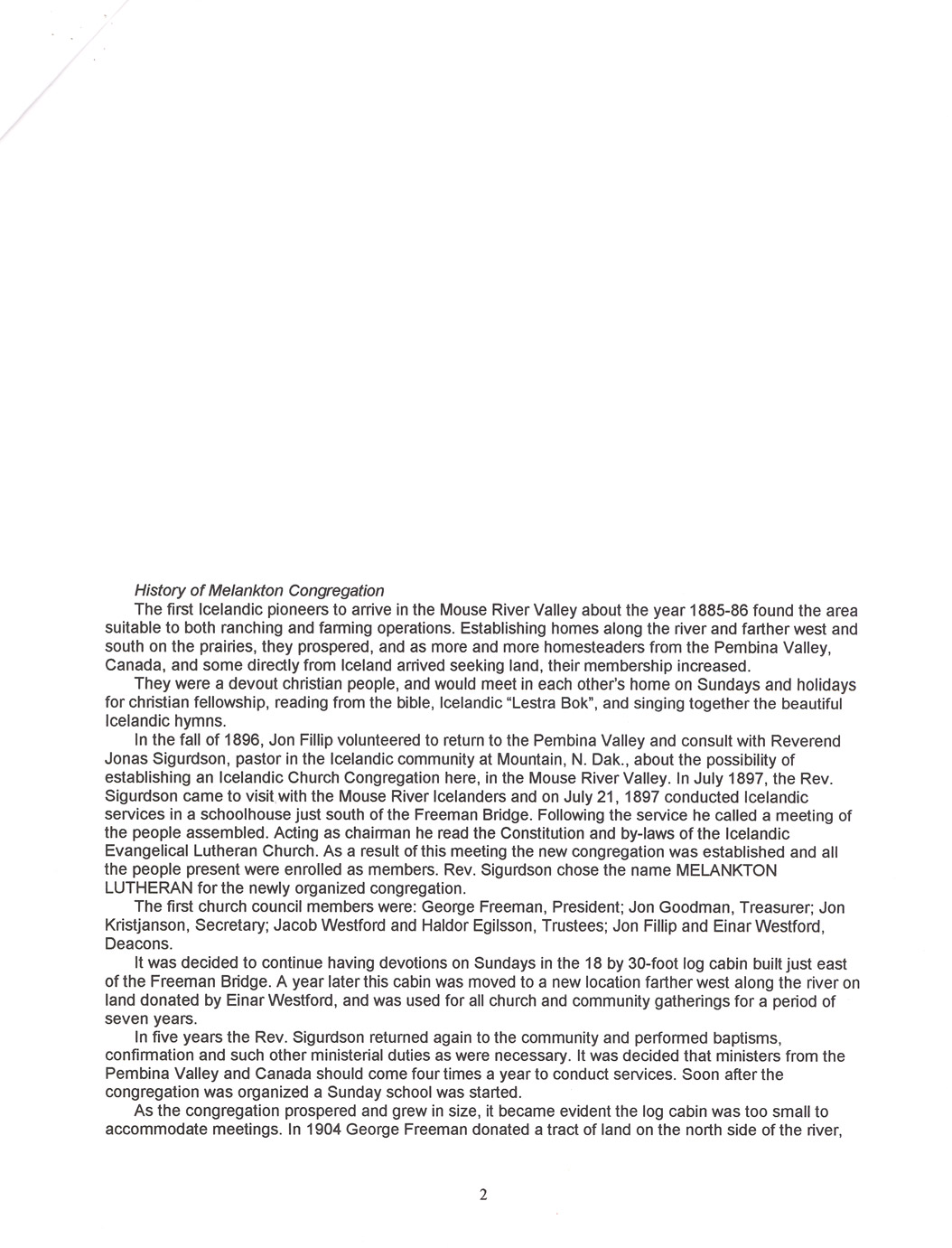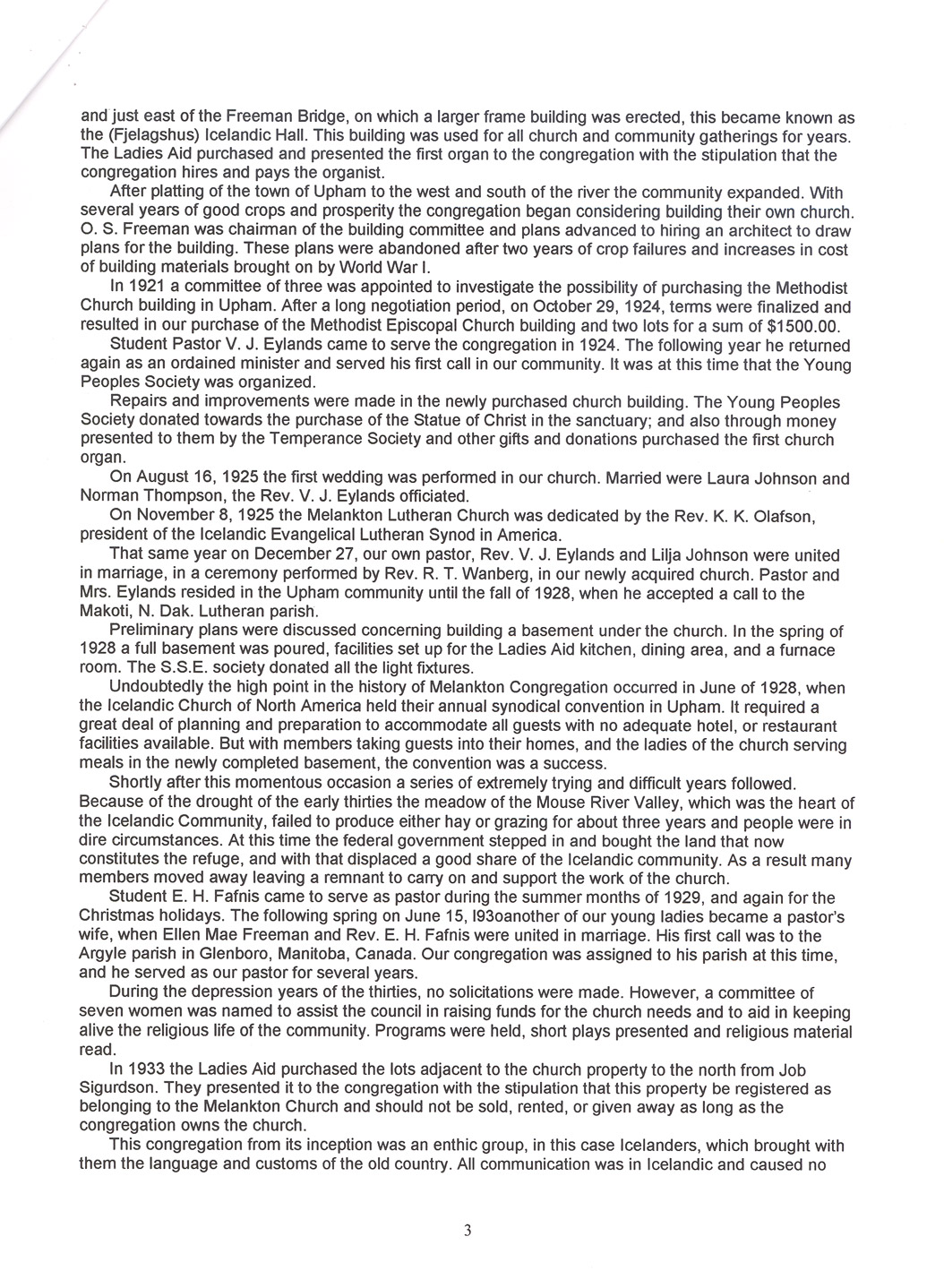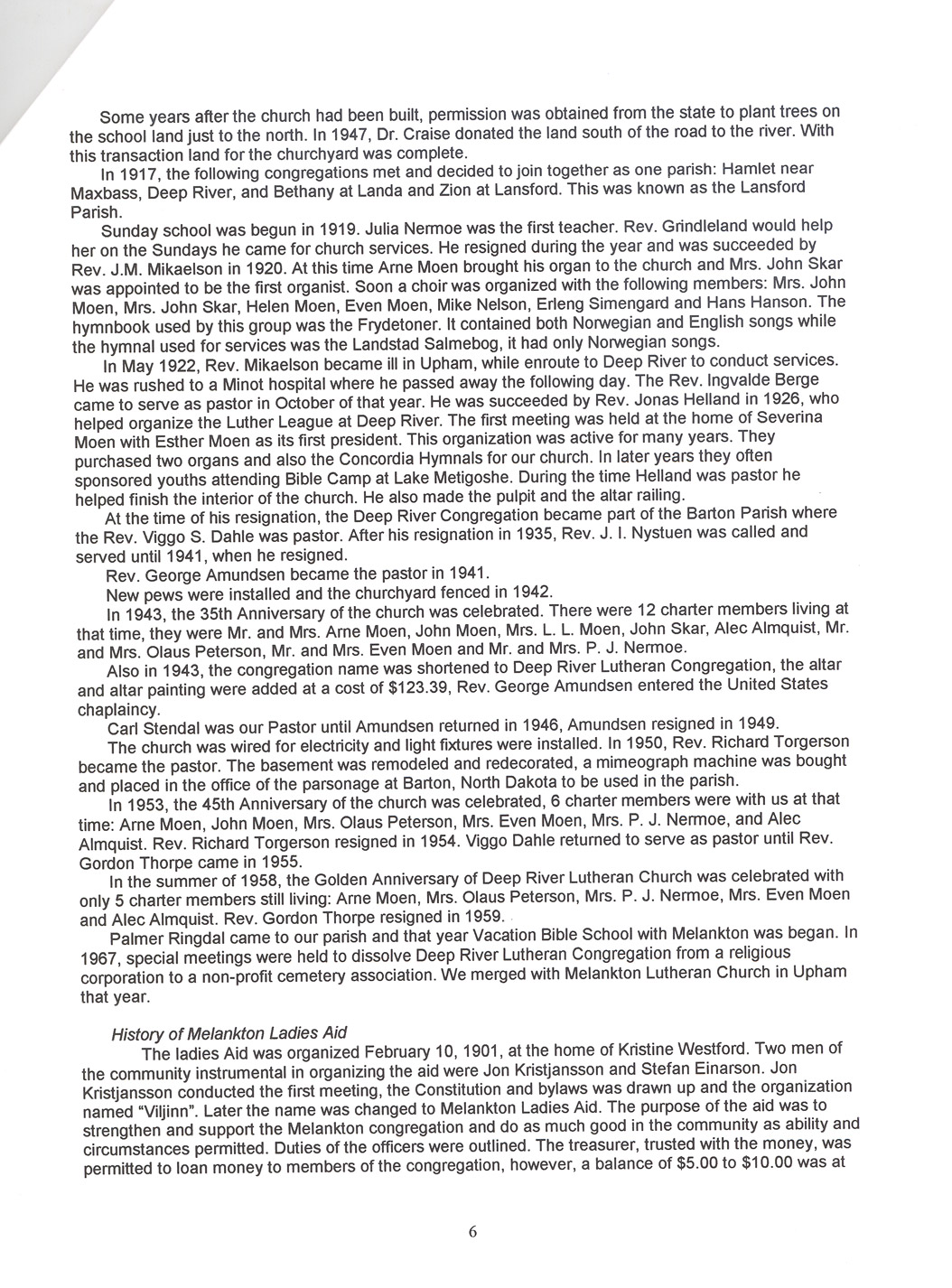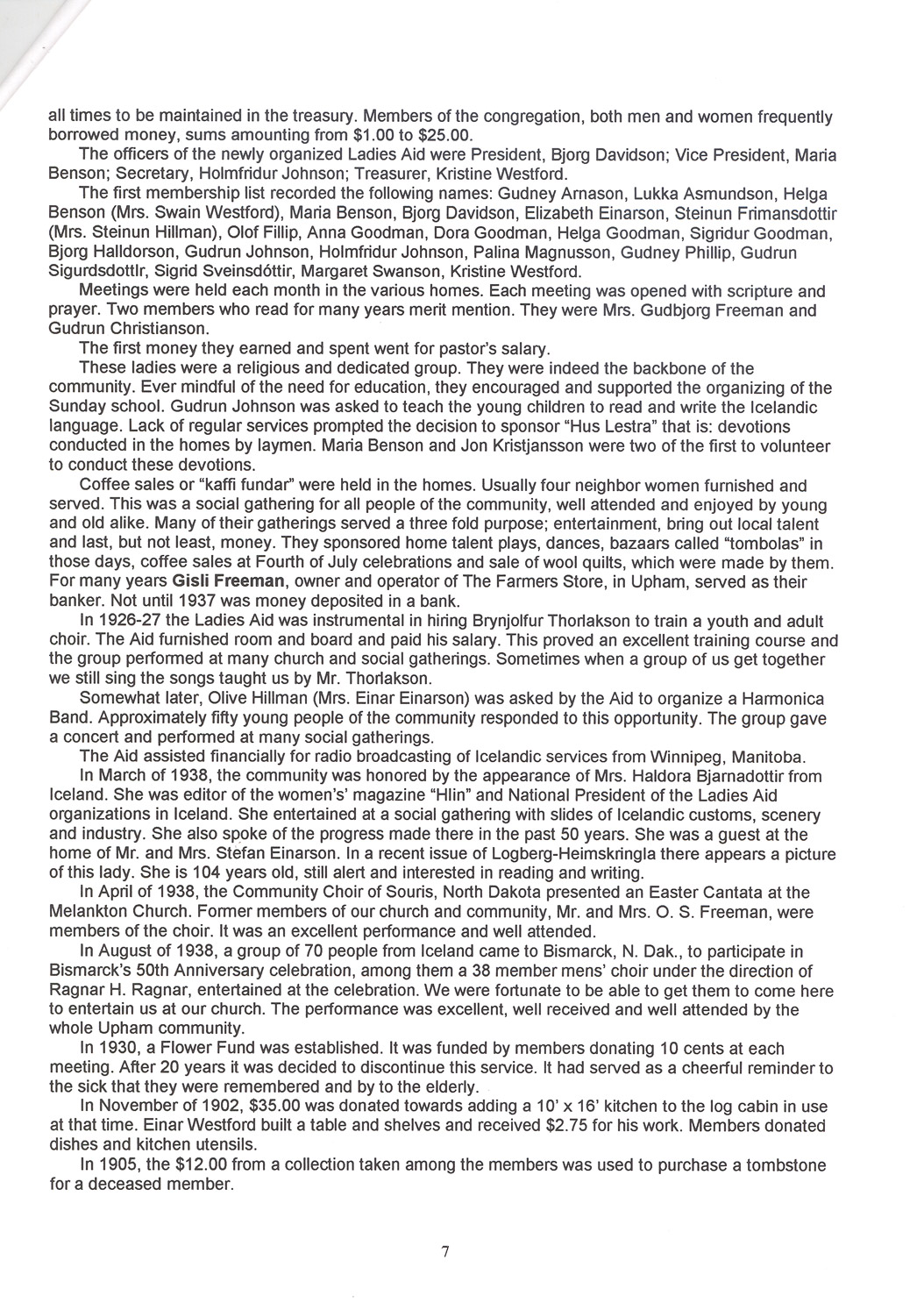When the Icelandic pioneers settled in the Mouse River Valley in 1885, they had several things to think about. Would the land be productive enough to support their families? Would they be able to remain together in this new place? Would fellow Icelandic Protestants join them so that they could establish a church?
The Icelanders met in private homes to pray and sing hymns, but they did not have a minister until 1897 when they formed the Melankton congregation. The congregation began meeting in a log cabin. When the congregation became too large for the cabin in 1904, the members built a church building. Whether they were in the log cabin, a private home, or a church, they made faith and worship the center of their Icelandic community life. The history of the Melankton Church is typical of many other pioneer churches in North Dakota.
Many churches were affiliated with an ethnic or religious group. However, some pioneers attended a church in their neighborhood even if they were not part of that denomination or ethnic group. That was true of Ladies’ Aid Society meetings, too. Everyone was welcome at church services and Ladies’ Aid meetings. A place to worship and visit with neighbors was important to everyone.
Christian churches did not exclude anyone, but most pioneers wanted to worship in familiar language and traditions. Religion and culture brought pioneers together in community groups to preserve their faith and traditions. The German Brethren would not have immigrated to North Dakota as individuals. The members of the Brethren church wanted to retain their religious traditions which were based on a community of faith. Members of particular faiths often immigrated as a group. Those who immigrated as families or individuals often sought to locate land near others of their faith.
As young people grew up in these religious communities, they thought about their own commitment to their faith. Young Bernadine Bickler chose a religious life because of the religious environment of her home and community. Her choice to become a nun was highly respected by her family and members of her congregation. Her father’s question, “Are you home for good now?” was not a challenge to her choice, but a test of the strength of her commitment.
Why is this important?Freedom to worship as we please is a founding principle of the United States. The pioneers of North Dakota were very serious about acting on their freedom to worship and to allow others to do so as well. Pioneers formed congregations as soon as possible and quickly built church buildings. When it was not possible to build a church, a gathering in a private home, a school, or another place suited their purpose.
Church life included many events other than weekly worship services. Youth groups, Ladies’ Aid, parochial school, and other events took place at or near the church. Churches tended to stabilize communities even when other events such as drought or economic problems weakened communities. As long as the church remained active, the people could say that they had a community.
The Melankton Church History
Many churches celebrated important anniversary dates. The Melankton Icelandic Lutheran Church celebrated an anniversary with a special worship service. The program for that service included a history of the church. (See Document 1)
In many ways, the history of a church, or a congregation, is a history of a community. The church building reflects on the success of the community. If the church includes a school, the congregation may intend to teach traditional culture of the church and community to the young people. When a church closed, it may have been because the members of the congregation moved on to other places.
The Melankton Icelandic Lutheran Church faced many challenges as it struggled to grow in McHenry County. The congregation had to balance material needs such as raising funds to buy land for a church building, with the spiritual needs of the members. While some of the facts in the history may seem pretty ordinary, it is good to remember that marriages meant that the congregation would grow with more children. When a young woman of the congregation became a pastor’s wife, the congregation knew that it had done well in raising its children in the religious spirit.
Why is this important?While this history contains much information that is specific to this congregation, this is also the typical story so many pioneer churches. The churches, particularly those located in rural areas, struggled for survival as did the members. The church members drew on the church and the congregation for help when they needed it, and the church formed a strong foundation for the community.
Source: Melankton Church, SHSND Archives GIF
The German Baptist Brethren
They were often called Dunkers or Dunkards. The name has a funny sound to it, especially for a religion, but it is closely tied to the religious practices of this group. The name is a corruption of the German word tunken which means “to dip.” The term was given to the German Brethren for their baptism ritual of three immersions in water.
More formally they were called the German Brethren or German Baptist Brethren. Members of this religion had organized a church in Pennsylvania decades before the American Revolution. Many of these “Dunkards” were energetic and capable farmers who lived in tight-knit communities. By the late 19th century, members of this church had spread into Indiana.
It was Max Bass, the director of immigration for the Great Northern Railroad (GN), who encouraged the German Brethren to come to North Dakota. Bass, a native of Austria, had come to the United States in 1877. By 1883, he was had founded the town of Belfield, Dakota Territory. In 1886, he was named Deputy Commissioner of Immigration for Dakota Territory. With a great deal of personal experience in immigration and in community development, he went to work for the Great Northern Railroad in 1892 as director of immigration.
Bass wanted to bring Amish farmers to North Dakota. He knew they were good farmers and would support communities along the GN line. Though the Amish were reluctant to leave their good farm land in Indiana, Bass believed that religion was the key to organizing colonies of settlers to move to the lands along the Great Northern Railroad line. Judge F. L. Thompson of Cando suggested to Max Bass that he contact members of the German Brethren church in Indiana. The Dunkards sent their minister, A. B. Peters, and a few other men to the Cando area to look at the land. They were pleased with the prospects and chose land for their group.
In the spring of 1894, a Great Northern train brought 350 people, livestock, and equipment from Indiana to North Dakota. They had a difficult journey. They traveled in train cars called “immigrant cars.” These were not designed for travel comfort. Only women and children had beds. The only food they had was what they had brought with them. The trip took several days. For a while, they ran out of water.
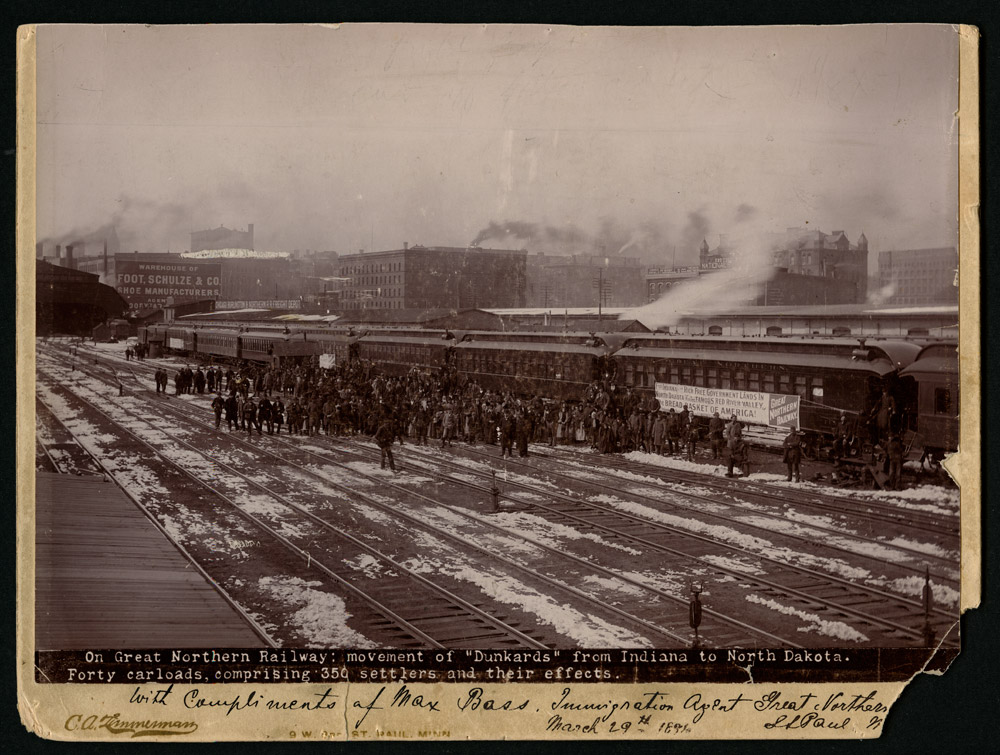
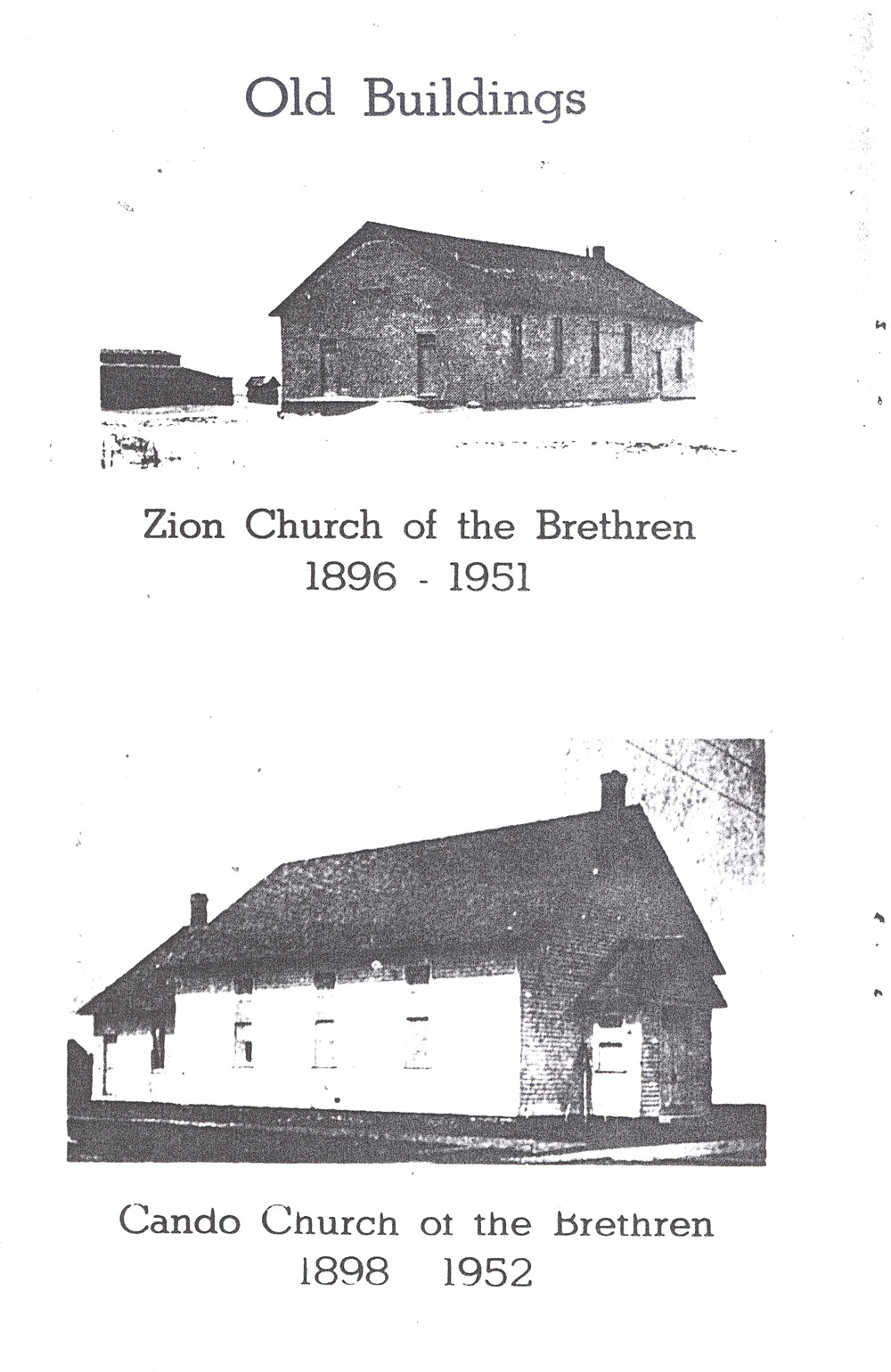
When the train reached St. Paul, Minnesota where the GN had its headquarters, the railroad company purchased lunches for the entire group and made a promotional photograph of the group standing by their train. (See Image 3)
The train finally arrived in Cando where the residents made the German Brethren welcome. The first thing the group did was to arrange a worship service. They borrowed the Methodist church building where Reverend Peters conducted the first German Brethren worship service in North Dakota. Over the next several months, the congregation met in the county courthouse and in schools. The Church of the German Brethren, called Zion, officially organized in August, 1894. (See Image 4) Over the next two years, 150 more Brethren came to North Dakota.
Why is this important?North Dakota’s pioneers came for a variety of reasons. The history of the German Brethren colony at Cando tells us of a different migration pattern. The Great Northern recruited new settlers because of their religious organization. In North Dakota, the Brethren found the land that would allow their religious group to remain close while they made a good living from their farms. From this beginning, the first church, Zion, became the “mother church” of all Brethren churches in North Dakota and Montana.
Source: Roy Thompson, “The First Dunker Settlement in North Dakota.” Collections of the State Historical Society of North Dakota vol. 4 (1913): 83 – 91.
Ladies Aid Societies
The Ladies’ Aid Society was one of the most important and powerful community organizations in North Dakota between 1870 and 1910. In some communities, women organized a Ladies’ Aid Society even before a congregation had formed. Almost every rural community had a Ladies’ Aid Society which provided women with a place to pray, study the Bible, and socialize with other women. Though they are often ridiculed, Ladies’ Aid Societies accumulated impressive social, political, and economic power in the early days of settlement.
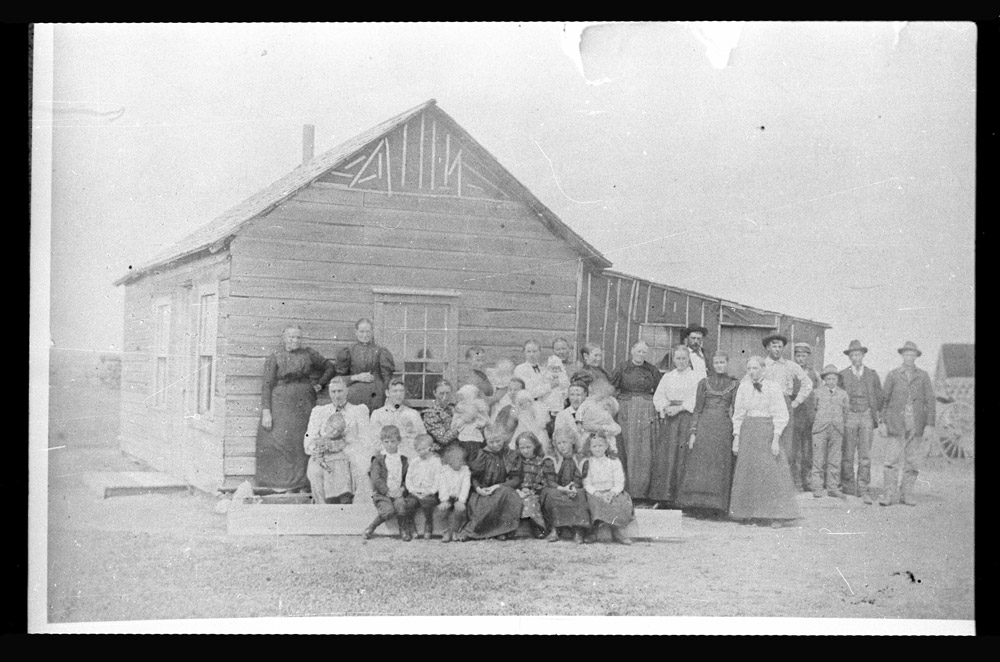
Quite often Ladies’ Aid Society meetings included the entire family. (See Image 5) Men gathered outside the house or in the barn to talk about crops, weather, politics, or community news. Older children played; babies slept in the house. In East Fork township in Benson County, bachelor homesteaders hosted Ladies’ Aid meetings, providing cookies, coffee, and lunch. By hosting the Aid meeting, bachelors were able to socialize with the other men and establish their own place in the community.
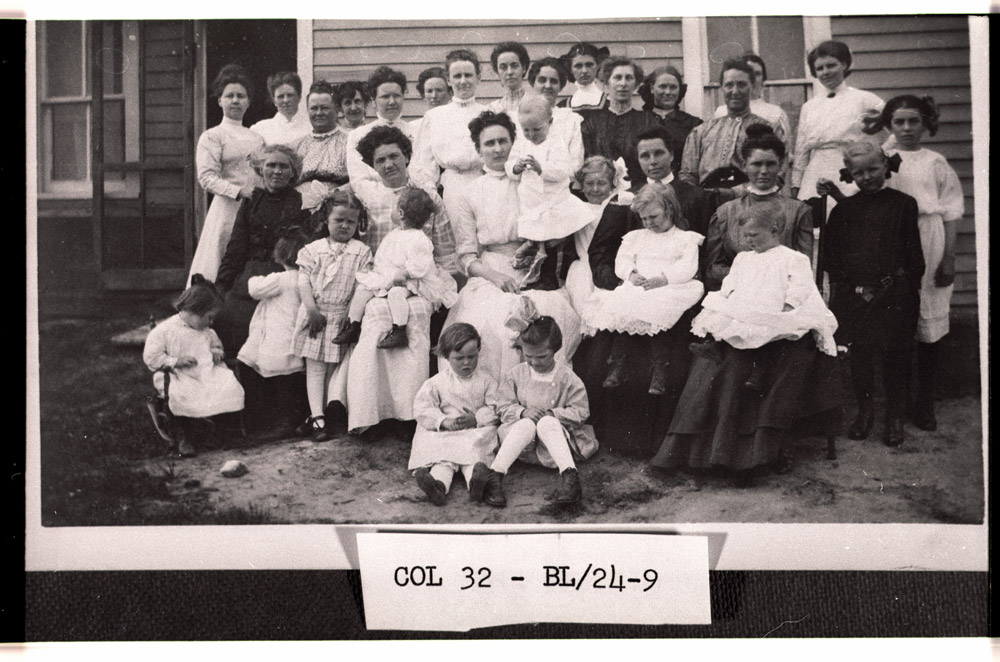
The real power of Ladies’ Aids lay in their ability to raise money. Each woman paid a small membership fee. These fees brought in a couple of dollars each month. (See Image 6) During the meetings, the women sewed and knitted. The goods they produced might be fancy knitted bedspreads, or plain long underwear. Sometimes they made bed quilts or knitted socks and mittens. Mrs. Pederson of the Froen Ladies’ Aid of Horace went to Fargo where she purchased $20 worth of cloth on credit. At the next meeting, the other members cut and sewed the cloth into “ladies’ aprons, men’s shirts, underwear and children’s clothing.” After these pieces were sold at the Ladies’ Aid auction, the group paid off its account at the store and purchased more cloth. Some Aids put their money in a bank to earn interest; others gave the cash to the treasurer who sometimes placed the cash in a jar and buried it in her yard.
Ladies’ Aid Societies raised enormous amounts of money. Between 1870 and 1916, the Froen Ladies’ Aid raised $10,000 ($266,037 today). Another Horace group, the St. John’s Ladies’ Aid, raised more than $1500 ($40,118 today) between 1890 and 1900. The money raised by the Ladies’ Aid went to the support of the local congregation. The Norway Ladies Aid of Aneta purchased the pastor’s stable, church chairs, churchyard fence and gate, baptismal font, lamps, altar, pews, drapes, and organ. Once the church was well-established, the Ladies’ Aids sent their money to foreign and domestic missions.
Ladies’ Aid auctions and socials usually took place at Fall Harvest Supper or Fourth of July picnic. These events were attended by everyone, even those who did not belong to that church. Through community meals the women of the Ladies’ Aids spread their influence throughout the community. The members of the Goose River church of rural Hatton, served lunch on election day in 1888, hoping to reduce the role of alcohol in election day celebrations.
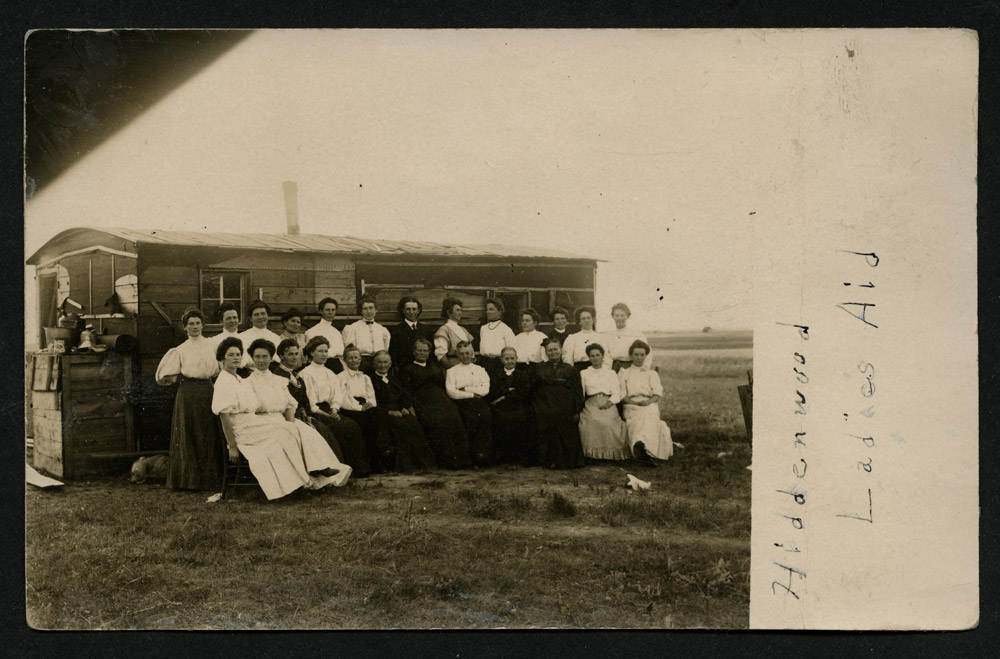
On meeting day, women completed their usual chores early and left cold meals for their husbands and children who stayed home. (See Image 7) If they lived within two miles of the meeting, they usually walked, often knitting as they walked. Mrs. Gronlid walked one and one-half miles carrying her baby and a bag of rags for making rugs at her Ladies’ Aid meeting. Two toddlers walked along behind her. Other women found some sort of transportation. Mrs. Heskin rode an untrained, wild colt carrying “the sack” which contained all the cloth for the meeting. One woman traveled to the Norway Church Ladies’ Aid meeting on a hay rake drawn by a pair of oxen. Some of the women attended meetings in defiance of their husbands.
Ladies’ Aids served the needs of their members, their communities, and their churches. However, their ability to raise money sparked their interest in how the money was spent. Though women seldom sat on church governing councils before 1920, Ladies’ Aids voiced their opinions through the money they raised and controlled. At the time that the Beaver Creek Lutheran Church was considering building a church, the congregation was also struggling with a decision about which synod (national church affiliation) to join. The Ladies’ Aid resolved the question when they voted to give their money for the construction of a church provided that the council agreed to join the United Norwegian Lutheran Church of America.
Why is this important?The significance of Ladies’ Aid Societies can be seen in many ways. Many of the churches they funded still stand. In some communities, men noticed the financial power of the Ladies' Aid and tried to organize in similar ways. In the town of Hope in Steele County, the “Men’s Ladies’ Aid” constructed an album quilt. Each man stitched his name onto a square piece of cloth. The squares were joined together in a quilt which was sold at auction after the men proudly posed for a picture with it. In other communities, men took over the role of the Ladies’ Aid and hosted Harvest Suppers.
Ladies’ Aid meetings gave women experience in leadership roles. Mrs. Lynner of the Trondenes Aid negotiated with the manager of a lumber company in Sharon for a lot on which the church would be built. As community leaders, Aids established control over men’s behavior both within the church and in the community at large. Members wrote constitutions, elected officers and voted on important decisions.
Aid membership gave individual women a visible and important position. As Mrs. Teman Berg of Kindred noted, “Sociability was not their only aim. Their organization was a strong arm of the church and ranked high in esteem and hard work.”
Sources: Evangelical Lutheran Church of America records. III. Vol II. Box 71, 73, 77 Luther Seminary, St. Paul, Minnesota.
Young People and the Church
One of the occupations open to young North Dakotans was the religious life. Young boys could chose to be a minister, pastor, or priest. Young girls could choose to become nuns (if they were Catholic) or deaconesses (nurses) in the Lutheran Church. Girls could also marry a minister and become, through marriage, a missionary. Girls could not become ministers in Protestant churches until late in the 20th century.
Pioneer churches raised their children in the traditions of the church. It was through the church that children often learned the culture of their parents and grandparents. On the other hand, it was the influence of young people in the churches that encouraged congregations to conduct services in English. While the transition was difficult, the compromise with the young people’s American outlook helped to maintain the churches over several decades.
When a young person chose a religious life, the parents were usually quite proud, but there was also the problem of the loss of that child to the community and the family farm. However, the family and the entire congregation supported and celebrated the young person’s choice.
The religious life often took a man or woman far from home to serve the church. Others, however, were, like Sister Bernadine Bickler, able to remain close enough to home for an occasional visit. (See Document 2)
Why is this important?The interest of young people in religious life, began while they were children in their community’s church. Young people helped to make the church a social center. Young people also “Americanized” the churches of their immigrant parents. When young people chose a religious vocation, the congregation knew that its faith would be preserved in years to come.
Source: The MARS Message (1913) SHSND Archives GIF
Document 2. Interview with Sister Bernadine Bickler
Michael Miller of the Germans from Russia Heritage Society interviewed Sister Bernadine Bickler in 1996 at the Convent of St. Francis, Hankinson. In this short excerpt, Sister Bernadine tells of her decision to become a nun. Presented with kind permission of the Germans from Russia Heritage Collection, North Dakota State University Libraries, Fargo – www.ndsu.edu/grhc. To read the entire interview: http://library.ndsu.edu/grhc/history_culture/oral/samples/bickler.html
MM: What were the strong religious influences in your life? Were there some strong religious influences from your home that made your decision to join the convent?
BB: Well, that and also I had an uncle going to St. John's [Collegeville, MN] and we wrote quite a bit to each other. He was going to be a priest but he didn't make it. Also on my mother's side, on the Thomas side, there was also a nun I had corresponded with. But then before I was sixteen, all of us in those days did, my brother and I were shocking and we'd always shock so we'd have one row that we could rest. We always stayed behind the binder. I don't know, all of a sudden it was just like something told me that you should go to the convent, but I didn't think that was anything. Then we had retreat master, Father Theophilis, who was a saint. He spoke to the boys and the girls separate and when he spoke to us, I was then 15 years old, and when I came out of the church, my aunt was with me, my dad's sister, I said, "Well Aunt Margaret, I am going to go to the convent. I know what I am going to do." She turned to me and said, "You? I don't think you'd make a good nun" or something like that. I left it at that until I was past eighteen already but this urge was coming to me stronger and stronger. Then I finally wrote to my uncle and didn't tell my parents at all. Then at that time, the girls that were leaving from Orrin or Balta parish were going to Bella, New York. I thought that was an awful far way to go away. Then my uncle wrote back and said, "I have already talked to the sisters down here". At that time, the sisters cooked at St. Johns in Collegeville. They said you can come anytime to Hankinson. You have a mother house right in Hankinson, you don't have to go to New York. Well, what am I going to do now? What am I going to do with this letter? Then I showed the letter to my mother and she said, "Are you really serious?" I said, "Yes I am serious." Then she told me I would have to talk to dad. It took me a few days to get nerve enough to tell dad. He didn't say anything for a while, I just gave him the letter. Finally he said, "You know when you go, you can't come back anymore." In those days, the Sisters didn't go home anymore. I said, "I know that, but I still want to go if I may." "If that's what you want," he said, "then okay." That was it.
MM: So, you had some encouragement from the home?
BB: Yes, I had some encouragement from the home. They didn't say, "No, you can't go." I was quite a bit older than my siblings were and in those days, we were poor. We didn't have much so I thought if they don't let me go, I will just have to wait until I'm older. But in those days, the girls already got married at eighteen or nineteen years old. I was old enough now to go out on my own and do my own thing. I didn't want get married, I wanted to be a sister.
MM: And you were in a strong Catholic community, so you had some encouragement from other people too?
BB: So that's how I have been blessed.
MM: Now beyond prayer and worship, how was the family involved in the parish? Were they involved in the parish work?
BB: Our parish was in Orrin. We went to school in Balta, but we went to the Orrin Parish because we were only four miles from Orrin. I always say the Germans from Russia were very strong in their religion. It meant a lot to them and it did and to us kids too because our parents were. In the beginning, the priests had a German and an English sermon, so we had to sit through the two sermons. We had only mass every other week because Blumenfeld was a mission to Orrin and so they always changed off. Then every time we went to church, we had to go to confession. I said to mother, "Well, why do we always have to go to confession when we go to church?" She said, "Don't you think you've got any sins in two weeks?"
MM: What were some of the religious training that you received after you left Pierce County?
BB: After I came here? Well, I was a postulent then for six months and I still had to go to school because I did not finish school. At the same time, I was finishing high school here. I didn't finish school at home because I had to stay home and work because I was the oldest. Years later, after I was a sister, I met my county school superintendent and she said, "I always felt so sorry for you because right at the time we were almost ready for the final exams in the 8th grade, you had to stay out and do the work and you didn't come back and finish." "Well," I said, "My dad needed me and I didn't think I needed it anyway." When you are kids, you don't think ahead. But I had a very good training here. I was here two year before I entered the Novitiate, but I finished my high school here.
MM: Once you came here, did you have to have financial support from home?
BB: At that time we didn't because of the fact in those days, it was during the depression years. We didn't have to. But we had to work here too. We worked.
MM: So once you came here to Hankinson, was there much contact with back home those early years?
BB: Only by letters. Although when I first came, one year I was still going home. The first time I came home was..., I came in April and this was in July and we were sent home until school started again. We first had to go to summer school and then we were sent home. When I got off the train and my dad said, "Are you home for good now?" I says, "No dad, only for two months and then I go back again." He thought I had enough already of the convent.



